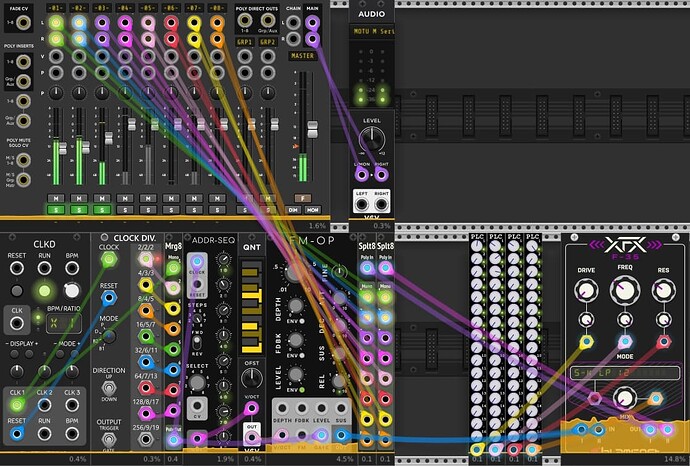Inspired by the recent thread on polyphonic utilities and a few other discussions, I thought I’d start one on polyphonic effects, or audio processing modules.
What does that mean? Genuinely polyphonic effects modules apply a discrete instance of the effect on each channel with a polyphonic input. If you think about the traditional pedal format in hardware, you can think it as splitting your signal into multiple cables, and sending each one to an identical but separate pedal. For example, say you have a flanger pedal. Now imagine you buy sixteen of them and run them in parallel, what would that sound like? Probably not great if they’re all on the same setting. But imagine you can change all the settings at once on all the pedals (polyphonic modulation).
I’ve included a few filters where they have effects modes, although any filter is an audio effect, some filters have comb, resonator, or phaser modes for example.
Also, some modules are labelled polyphonic but actually just accept a poly input and sum it to mono or stereo signals. We’ve already had that debate, so for the list here I’m only including poly modules that fit my definition of discrete processing per channel.
Here’s a quick list, which I’ve split by free and premium. It’s not at all comprehensive, so feel free to suggest any additions or a better way to categorise.
Free:
Sapphire: Echo
Airwindows: all effects (I think)
DocB: CWF, CWS, LWF, CLP, JWS (wavefolders), AP (allpass filter), DRM (ring mod)
Surge XT: Chorus, Phaser, Flanger, Filter, Nimbus (Clouds), Frequency Shifter, Bonsai, CXOR, TreeMonster, Combulator, Ensemble, Resonator, Chow, RingMod, Neuron, Vocoder, Distortion
Bisset: It’s Good Cholesterol (takes mono or stereo input, but can produce poly output via multiple playheads)
Blamsoft: XFX filter (insane effects modes!)
Bogaudio: Pan, LMTR (limiter), CLPR (clipper), Pressor (compressor), CVD (delay)
Count Modula: Rectifier, Mangler
KRT: J (all-pass filter/phaser), G (Compressor)
Mockba Modular: Pannah, ASSprdr (stereo spread), Tuube
Sanguine Mutants: Anuli (MI Rings clone, can process audio), Mutuus/Incurvationes/Distortiones (MI Warps clones), Werewolf (distortion)
Stocaudio: PolyDelay, Spread
Studio Six Plus One: Massarti, Wallenda
Squinky Labs: Comp, Comp II
VCV: Fade
Venom: Reformation (hard/soft clipping, wave folding, regionalized AM, general wave distortion) Wave Multiplier, WinComp (rectifier, clipper, etc) Shaped VCA, Quad VC Polarizer, VCA Mix 4 and VCA Mix 4 Stereo (clipping, ring modulation, AM) Bernoulli Switch and expander (audio rate switching with audio signals can create stereo effects)
Logic (interesting results with multiple audio rate inputs)
VCO Lab / VCO Unit - built in VCAs, can be used for ring modulation or amplitude modulation
Vult: Rescomb, Debriatus, Jorus, Nopskate, Flame, Decline, Wolv
ZZC: SC-VCA (soft clipping limiter)
Premium:
VCV Pro: Phaser, Flanger, Chorus
Unfiltered Audio: Instant Delay, Pitch Delay, Glitch Shifter, Fusion

